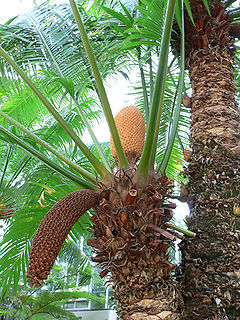
Cycadales is an order of seed plants that includes all the extant cycads. These plants typically have a stout and woody (ligneous) trunk with a crown of large evergreen leaves. They usually have pinnate leaves. The individual plants are either all male or all female (dioecious). Cycads vary in size from having trunks only a few centimeters to several meters tall. They typically grow very slowly and live very long, with some specimens known to be as much as 1,000 years old. Because of the superficial resemblance, they are sometimes confused with and mistaken for palms or ferns, but are only distantly related to either.

The Zamiaceae are a family of cycads that are superficially palm or fern-like. They are divided into two subfamilies with eight genera and about 150 species in the tropical and subtropical regions of Africa, Australia and North and South America.
The Palm and Cycad Arboretum at the Florida State College at Jacksonville is located on the south campus at 11901 Beach Boulevard, Jacksonville, Florida, United States. This is an outdoor area next to the G building, a large three-story complex in the middle of campus that houses the library and other facilities. There is also a biologically diverse area of larger trees and mid-growth brush in an immediate westerly direction to this area. As the Arboretum is an open area, there are no specific set hours, and its use is free and available to all students and visitors.

Dioon is a genus of cycads in the family Zamiaceae. It is native to Mexico and Central America. Their habitats include tropical forests, pine-oak forest, and dry hillsides, canyons and coastal dunes.
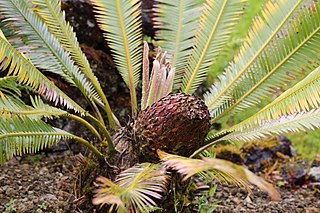
Dioon edule, the chestnut dioon, is a cycad native to Mexico, also known as palma de la virgen. Cycads are among the oldest seed plants and even pre-date the dinosaurs. It belongs to the Zamiaceae plant family within the order Cycadales. The genus name "Dioon" means "two-egged", referring to the two ovules.
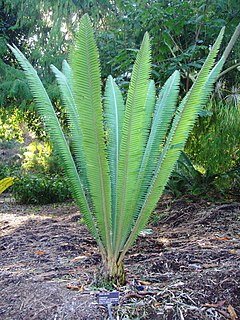
Dioon mejiae is a species of cycad that is native to Honduras and Nicaragua. In Honduras, it is found in the departments of Colón, Olancho, and Yoro. Common names include palma teosinte, teocinte, teocinta (female), teocintle, teocsinte, teosinte, tiusinte, and tusinte, all of which mean "sacred ear."

Dioon spinulosum, giant dioon, or gum palm, is a cycad endemic to limestone cliffs and rocky hillsides in the tropical rainforests of Veracruz and Oaxaca, Mexico. It is one of the tallest cycads in the world, growing to 12m in height. The tree is found at low elevations to 300 m above sea level.

Dioon purpusii is a cycad tree endemic to a very small region in Mexico. It is found in Tomellín Canyon and the eastern branches of La Cañada de Cuicatlán.
Teosintes are several wild species of grass in the genus Zea which are critical components of maize evolution.

Aulacaspis yasumatsui, or cycad aulacaspis scale (CAS), is a scale insect species in the genus Aulacaspis that feeds on cycad species such as Cycas revoluta or Dioon purpusii. Other common names include the cycad scale, the sago palm scale, and the Asian cycad scale. This is a serious pest of cycads which can kill its host plant.
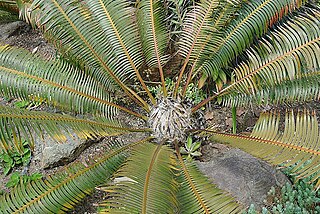
Dioon tomasellii is a species of cycad in the family Zamiaceae. It is endemic to Mexico, where it occurs in the states of Durango, Guerrero, Jalisco, Michoacán, and Nayarit.

Dioon califanoi is a species of cycad that is native to Oaxaca and Puebla states, Mexico. It is found near Teotitlán del Camino and Huautla de Jiménez.

Dioon holmgrenii is a species of cycad in the family Zamiaceae. It is endemic to Mexico, where it occurs only in an area just to the southwest of San Gabriel Mixtepec, Oaxaca. It is known by the common name palma del sol.

Dioon merolae is a species of cycad that is native to Chiapas and Oaxaca, Mexico. It is known from the municipalities of Cintalapa and Villaflores in Chiapas, and from the Sierra Juárez, Oaxaca.

Dioon rzedowskii is a species of cycad that is native to Oaxaca, Mexico. It occurs in the Rio Santo Domingo valley, near the villages of San Bartolome Ayautla and San Pedro Teutila.
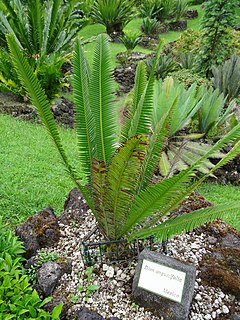
Dioon angustifolium is a species of cycad that is endemic to Tamaulipas and Nuevo León, Mexico.

Dioon caputoi is a species of cycad that is native to the state of Puebla, Mexico. It is found near Loma de la Grana, located 6 km southwest of San Luis Atolotitlán, Caltepec. It is protected by the Tehuacán-Cuicatlán Biosphere Reserve. As of 2018, there are only five or six known populations of Dioon caputoi remaining in the wild. Within each population are between 50 and 120, primarily adult, specimens that are distributed randomly throughout the dry scrubland.
Dioon argenteum is a species of cycad native to northern Oaxaca, Mexico.
Dioon stevensonii is a species of cycad native to Mexico.















